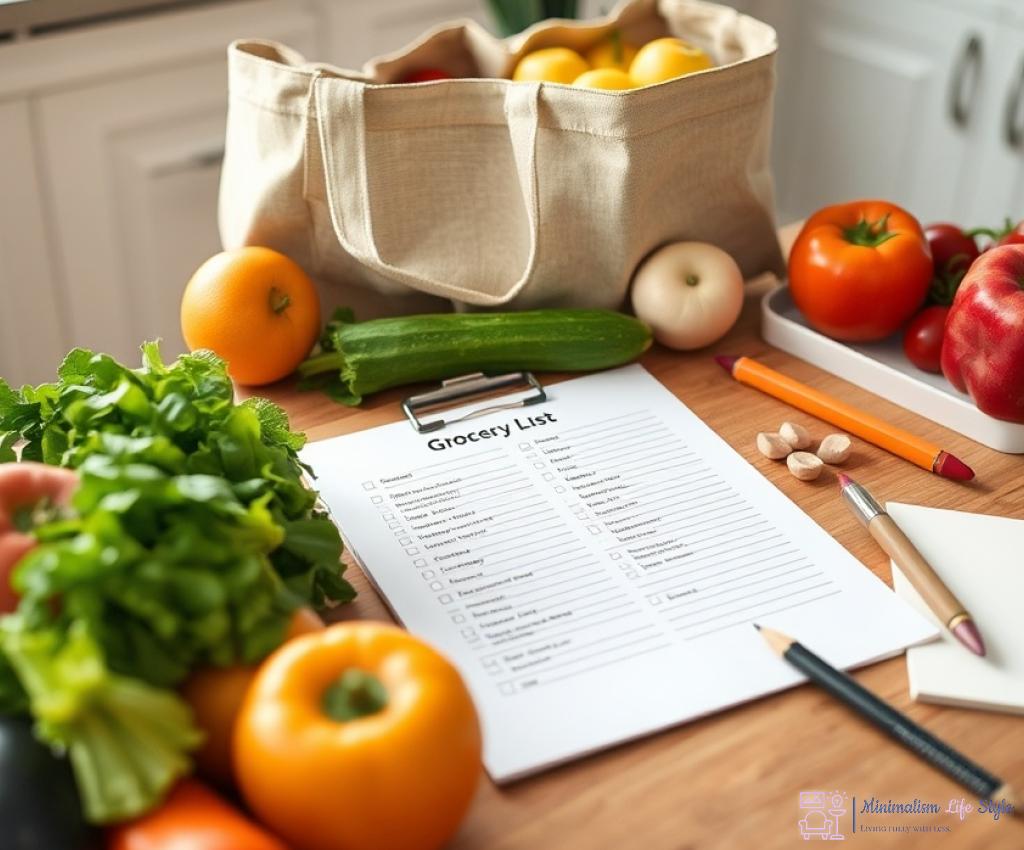Streamlining Your Grocery List

The Power of a Curated List
Creating a streamlined grocery list is more than just a practical step; it’s an art form that can transform your shopping experience and promote healthier choices. By thoughtfully curating your grocery list, you can eliminate unnecessary purchases, save time, and reduce food waste. Let’s delve into the strategies that will help you create a focused list that not only fits your dietary needs but also enhances your overall shopping experience.
Essentials Over Extras: Prioritize Your Needs
When it comes to grocery shopping, it’s easy to get lost in the aisles filled with tempting products. To combat this, start by identifying your essentials—those items that are crucial for your meals and snacks. By focusing on what you truly need, you can resist impulse buys and stick to your budget. Here’s a simple yet effective approach to prioritize your grocery list:
- Assess Your Pantry: Take stock of what you already have at home to avoid duplicate purchases.
- Plan Your Meals: Outline your meals for the week, considering recipes that use similar ingredients.
- Healthy Staples: Include whole grains, legumes, and fresh produce that can serve as the foundation for various dishes.
- Limit Processed Foods: Aim for whole foods and limit the number of processed items to enhance nutritional value.
Visualize and Organize: The Grocery Layout Advantage
Understanding the layout of your grocery store can significantly boost your efficiency. By organizing your list according to the store’s layout, you can reduce the time spent wandering the aisles and increase the likelihood of sticking to your list. Consider creating a table that categorizes your grocery items based on the sections of the store:
| Store Section | Items to Include |
|---|---|
| Produce | Fruits, Vegetables, Herbs |
| Dairy | Milk, Yogurt, Cheese |
| Grains | Rice, Pasta, Bread |
| Proteins | Chicken, Fish, Legumes |
| Snacks | Nuts, Seeds, Dark Chocolate |
By visualizing your shopping trip in this way, you can navigate the store more effectively, ensuring that you gather everything you need without wandering into distracting aisles.
Choosing Quality over Quantity
In a world where consumer choices are abundant, the principle of choosing quality over quantity has never been more vital, especially when it comes to grocery shopping. Embracing this philosophy is not just about spending more on fewer items; it’s about making smarter decisions that benefit both your health and your wallet. Understanding the difference between high-quality food options and their lesser counterparts can lead to a more satisfying and nutritious shopping experience.
When you focus on quality, you are not merely selecting food items; you are investing in your well-being. High-quality foods, such as organic fruits and vegetables, grass-fed meats, and whole grains, tend to be richer in nutrients and flavor. This can ultimately result in healthier meals that are more enjoyable, encouraging you to prepare and consume better options.
Decoding Nutritional Labels
To make informed choices, it is essential to decode nutritional labels effectively. While it may seem daunting, understanding what to look for can empower you in making better selections. Focus on key indicators such as ingredient lists and nutritional content. A shorter ingredient list often signifies fewer additives and preservatives, which is a hallmark of quality. Moreover, pay attention to the nutritional density of items; foods that provide a higher amount of nutrients per calorie are always a wise choice.
Consider this: a single avocado may cost more than a bag of chips, but the health benefits it offers far surpass the fleeting satisfaction of processed snacks. By analyzing the value of what you are buying, you can create a grocery list that reflects a commitment to health rather than mere volume.
Investing in Local and Seasonal Produce
Another cornerstone of quality-driven shopping is investing in local and seasonal produce. Not only does this practice support local farmers and economies, but it also enhances the quality of your meals. Seasonal fruits and vegetables are often harvested at their peak, ensuring superior flavor and nutrient content. Embracing this approach not only leads to fresher ingredients but also fosters a deeper connection to your community and the food you consume.
Additionally, local food systems typically have fewer transportation miles, which can translate to a lower environmental impact. Remember that every choice you make at the grocery store has a ripple effect—choosing quality over quantity not only benefits your health but also contributes to a sustainable future.
Mastering the Art of Meal Planning
Meal planning is the backbone of a successful minimalist grocery shopping experience. When approached with intention, it can simplify your life, reduce stress during busy weekdays, and promote healthier eating habits. The essence of meal planning lies in its ability to guide your grocery list, ensuring that every item purchased serves a purpose. This way, your meals become not just a necessity but an enjoyable adventure in the kitchen.
Creating a Weekly Framework is essential for effective meal planning. Begin by setting aside a specific time each week to outline your meals. Consider crafting a simple template that highlights each day’s breakfast, lunch, dinner, and even snacks. This structure allows you to visualize your week, helping you identify overlapping ingredients that can minimize waste and cut costs. For instance, if you plan to use spinach in a salad and a smoothie, you can purchase just the right amount without fear of it spoiling unused. In this way, you’re not only streamlining your grocery list but also embracing the spirit of minimalism.
The Power of Versatile Ingredients cannot be underestimated in the realm of meal planning. When selecting items for your list, opt for ingredients that can be transformed into multiple dishes. For example, grilled chicken can serve as the star of a dinner plate one night, while the leftovers can be tossed into a salad or mixed into a wrap the next day. This strategy not only saves money but also enhances your culinary creativity. By thinking outside the box and allowing your ingredients to shine in various roles, you can elevate your meals without cluttering your pantry with excess products.
Embracing Spontaneity is also an important aspect of meal planning. While having a plan is crucial, allow yourself the flexibility to make adjustments based on cravings, seasonal availability, or unexpected events. By incorporating a few “wild card” meals that can be quickly whipped up using pantry staples, you can maintain a balance between structure and spontaneity. This adaptability ensures that meal planning remains a joyful process rather than a rigid chore, making it easier to stick to your healthy eating goals.
Navigating the Store Like a Pro
Stepping into a grocery store can often feel overwhelming, especially with enticing displays and a plethora of options vying for your attention. However, mastering the art of navigation can turn this daunting task into a seamless experience. By adopting a strategic approach to your shopping journey, you can not only save time but also make healthier choices that align with your minimalist grocery list.
Understanding Store Layouts for Efficient Shopping
Each grocery store has its own unique layout, typically designed to encourage browsing and impulse buying. However, by familiarizing yourself with the general structure of your local store, you can navigate with purpose. Most stores follow a common pattern: fresh produce is often located near the entrance, while processed foods and snacks are strategically placed further inside. Knowing this can help you focus on healthy selections right from the start.
Utilizing a map-like approach to your grocery list can be a game changer. Instead of simply listing items, categorize them according to the sections of the store. For instance, if you’re headed for fresh vegetables, dairy, and grains, group these items together. This method not only streamlines your shopping experience but also minimizes the temptation to stray into less healthy aisles.
Mindful Shopping Techniques to Enhance Experience
As you navigate the store, practicing mindfulness can significantly improve your overall grocery shopping experience. This involves being fully present and aware of your choices as you move through the aisles. Take a moment to reflect on your list and assess whether an item truly aligns with your health goals or if it’s simply a craving. Engaging your senses is another essential technique; smell the fresh produce, feel the textures of grains, and observe the vibrant colors of possible choices. These actions not only heighten your awareness but also create a more enjoyable shopping atmosphere.
Additionally, consider the concept of shopping with purpose. Before you dive into your grocery list, remind yourself of your meal plans for the week and how each item will contribute to those meals. This mindset helps you resist impulse buys and stick to your minimalist approach. For example, if you’re tempted to grab a sugary snack, pause and think about how that choice will fit into your overall dietary intentions. This checks and balances approach cultivates a more thoughtful shopping habit.
Embracing Seasonal and Local Produce
Discovering the Flavorful Benefits of Seasonal Ingredients
When we talk about grocery shopping, the conversation often revolves around convenience and affordability. However, a transformative aspect that significantly enhances not only the quality of your meals but also your shopping experience lies in embracing seasonal and local produce. Seasonal ingredients carry an inherent freshness and flavor that is often lost in out-of-season produce, which has traveled great distances. By choosing to shop with the seasons, you not only elevate the taste of your dishes but also support sustainable farming practices that benefit your community.
Connecting with Your Community and the Environment
Engaging with local farmers and understanding the produce that is available at different times of the year fosters a deeper connection to your food sources. This commitment to local produce helps sustain local economies and reduces the carbon footprint associated with transporting food across vast distances. Moreover, shopping seasonally encourages you to experiment with new recipes and flavors, leading to a more diverse and fulfilling diet. Consider this: when you pick up a ripe tomato in the summer or crisp apples in the fall, you’re not just purchasing food; you’re participating in a cycle that nurtures both your health and the environment.
Creating a Vibrant Kitchen with Seasonal Variety
By incorporating seasonal produce into your meals, you cultivate a kitchen that is vibrant and alive with color and flavor. Each season brings its unique bounty, allowing you to explore different ingredients that can inspire creativity in your cooking. Think of a winter stew rich with root vegetables or a refreshing summer salad bursting with juicy berries. This variety not only satisfies the palate but also enhances your nutritional intake, as seasonal foods are often at their peak in terms of vitamins and minerals.




